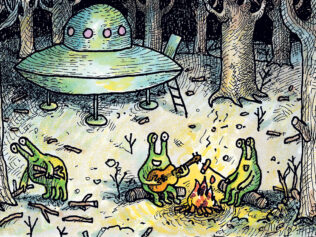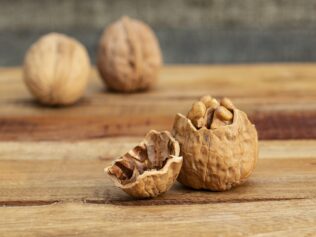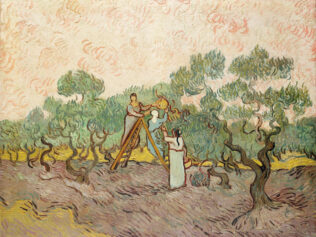
Sourdough bread, fermented herring, blue-veined cheese: the list of victuals enjoyed by people in various parts of the world includes many fermented, slightly spoiled, soured, or rotten foodstuffs.
Milk, vegetables, fruit juices, sometimes even meat. Over the course of hundreds or even thousands of years of culinary exploration, we have tried to ferment, or “spoil in a controlled manner,” just about anything. Never by ourselves, of course—we couldn’t do it without fungi and bacteria, the alchemists of the micro-universe.
We tend to think that we are in charge of the fermentation processes, that all these single- and multicell reactors are slugging along on our human leash and chew up and digest organic matter just because we allow them to do it. But when something goes wrong, the true dynamics of the relationship governing these processes becomes apparent. As soon as a fetid pest creeps into the Garden of Eden and the biochemical game goes awry, we get vinegar instead of wine, and our Moroccan pickled lemons are replaced by a downy blanket of decomposition. At this point, we are completely helpless. With our complicated, pretentiously clean bodies, with fluids hidden away in tubes and containers—we observe. And there it is: a frantic world of mucus, malodor and effervescence, a microscopic version of the primeval bush.
Planes of biofilm on vegetable skin, festivals of fornication and gluttony bubbling up in clouds of murkiness, suspended in a soft bath of sweet milk. Sometimes fermentation serves us what we want, other times it strings us along and produces incomprehensible and inedible chaos. And yet, we do everything we can to take advantage of this process—even if we don’t bother hiding the fact that we see the jellylike reality of decomposition as the very nidus of ugliness. “It has spoiled,” we say with disgust, as if fermentation is bad or superfluous, unless we get to eat or drink it its outcomes. And yet, fermentation almost always provides us with the opposite of something tasty: the bacteria and fungi that are responsible for this process most often produce things that are hideous and stinky, slimy and inedible. We tend to forget that this way of respiration is alien, at least to us humans. Why should bacteria or fungi be interested in our organoleptic comfort? Hence, the entire dictionary of ugliness: moldy, curdled, rancid, rotten, decayed, musty and—yes—spoiled.
The Work of Chance
To my mind, there is no doubt that when we ferment something, we enter into a relationship with beings almost endowed with a strange microbial personality. Every time I take a SCOBY out of a glass jar, wrinkly and grimacing, I can almost feel its disdainful indifference. “Why are you touching me?” it seems to complain—the lack of decent muscle being the only thing stopping it from punching me in the face. “Keep those rough, multicellular hands to yourself,” it adds in exasperation, or at least that’s how I imagine it when I remove the oldest, yellowed layers. After all, when brewed for long enough, kombucha becomes a book that writes itself: it grows thicker each passing week, and its successive layers resemble yellowing pages covered with the story of a life invisible to our eyes.
Each layer of a SCOBY is a microscopic universe, an intricate network of fibers of bacterial cellulose, bacteria, and yeast. Kombucha grows and “heals” any wounds it has sustained, while gorging on the sugar we generously provide it with. And it doesn’t care about personal appearance or the canons of beauty—why should the entire world care about how a strange, two-eyed entity from another dimension might see it? It is the same with sourdough: it makes itself comfortable on a shelf in the larder, its soft body spilling out, smelling sour and demands to be fed. It does not mind the periodical euthanasia of parts of its body, when it turns from frothy jelly into fragrant bread. So long as a part of it lives on and continues to absorb the spoonfuls of starch I obediently feed it.
All fermentation processes that have—throughout centuries—allowed themselves to become more intimate with humans appear similar. They look dirty, murky, primordial. We wince in disgust when they have the audacity to smell or froth up with a storm of fizzling carbon dioxide, or when we spot a teeming dross of plush mycelium and bacterial biofilm. We didn’t invent any of these processes because, after all, life cannot be “invented”—we simply stumbled upon them by accident. Someone accidentally discovered a pile of forgotten, moldy cheese in a dark corner of the cellar and, after tasting it, found it delicious. Someone else realized that imbibing the washings of bacterial life made them more cheerful as a pleasant feeling of warmth spread throughout his stomach and head. These are the taste and smell “eureka” moments relating to unwelcome, rotten foodstuffs rejected by clean, tidy people. Of course, one can argue about to what extent any of this was intentional—a methodical search for ways to make food more interesting—and to what extent it was mere luck. But the outcome is quite obvious: we are, for the most part, slaves to processes that we would like to control.
Microcosm
What is more, we do not understand many of the nuances associated with these processes. The biochemistry of human bodies and, in fact, of all vertebrates, has become a secret or even intimate activity over the course of millions of years. Encased in cellular organelles, it does what it is supposed to do in a fairly linear and predictable way. But fermentation processes are different. Microorganisms are exhibitionists. They greedily pounce on anything that appears in their environment and wallow in a soup made up of bits of food and metabolic waste. Microlife that some see as troublesome excretions, are, in fact, a favorite delicacy for another. In such an ever-flowing, ever-transforming galaxy of cells, substances, and genes, one can quickly lose the plot.
We can try to understand individual, isolated biochemical lifestyles by, for example, violently plucking a particular strain out of the living soup of ferment, growing it in a sterile pan, poking it and hoping that— because it lacks strength in numbers—it will show us what it can actually do. Sometimes this approach is successful, but even then, we get just one of millions of puzzle pieces that can fit in a thousand different places of the larger puzzle. And yet this puzzle—complete, alive and pulsating with energy—is the essence of fermentation. There, incomprehensible concoctions of disgusting substances are born. In specific quantities, they turn into unforgettable odors. This provides the scaffolding of microbial life, affords it space to operate, and helps create one-of-a-kind interactions.
I guess I like to play with fermentation to enjoy this very moment of communing with the messy, uncensored, secret life because, after all, it is invisible. I like to think about what will happen within different concoctions of water, salt, and plant tissues. What will the stuff— which I would never have left at the mercy of bacteria and fungi—actually taste like? Perhaps it’s the scientific curiosity, the thrill of experiment, and excited anticipation of the ugliness grown tenderly in the warmth. I don’t know. I am left at the mercy of the microscopic engineers and the methodical consistency with which they just do their thing. There’s also the fascinating thought: “What will be different this time? What will happen in the fizzy, murky soup? What will this fascinating tussle of life and death smell like tomorrow, the day after tomorrow, next week?” And life, after all, loves coincidence and surprises. As Louis Pasteur said, “fermentation is life without air” (la fermentation, c’est la vie sans air).










